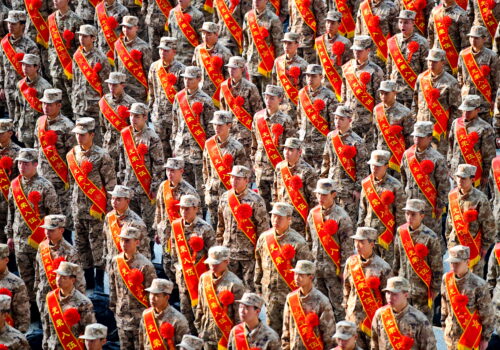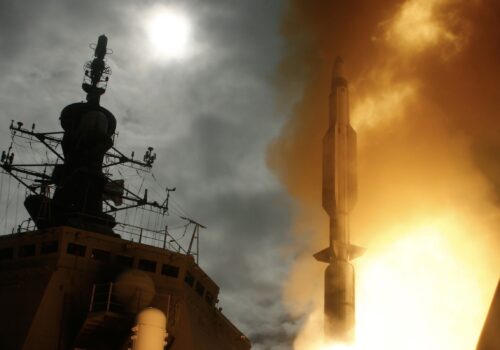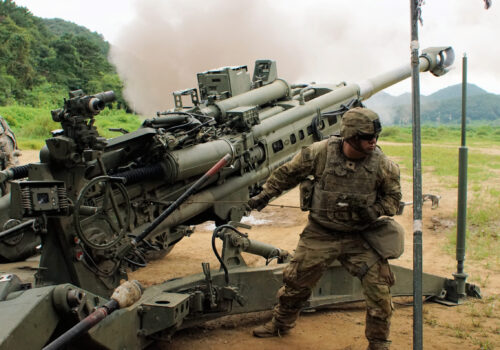The United States needs a victory plan for the Indo-Pacific

Click on the banner above to explore the Tiger Project.
The United States desperately needs to plan for a long war in the Indo-Pacific region.
A troubling gap exists between US industrial capacity and the production requirements to sustain and win a war with China. While such assessments generally focus on shipbuilding due to the maritime focus of conflict scenarios, the same disparity exists in military platforms across all domains of warfare, such as aircraft, armor, ground-based air defense systems, and others. Defense analysis on these myriad gaps is abundant, but most evaluations are piecemeal in nature, focusing only on a single platform or domain, rather than taking a holistic approach to the problem.
This disjointed assessment is compounded by the lack of a rigorous analysis of the wartime manpower requirements to operate new platforms. Producing the ships, aircraft, and fighting vehicles to sustain a war against China—which would almost certainly be protracted—isn’t enough. The platforms must also be manned and supported. A guided missile destroyer, for example, requires a crew of more than three hundred sailors. A single squadron of F-35B Joint Strike Fighters requires hundreds of maintainers, air controllers, fuelers, and other support personnel to remain operational. And while opening phases of a war with China would predominantly be an air and maritime fight involving ships, aircraft, and precision munitions, a long conflict fought for years would likely require nearly one hundred divisions of ground and amphibious forces from the US Army and Marine Corps.
Generating the personnel to man such a force would almost certainly require a draft—and getting the numbers right is itself a complex challenge that demands a delicate touch. The skill sets required for the force must be balanced against the domestic workforce’s nonmilitary needs. Skilled laborers and trained knowledge workers will be needed in abundance to sustain the production of a US war machine. In short, properly planning a national mobilization for a long war with China is a daunting task that has not yet been engaged in detail by the national security community. Developing even a “plan to plan” for mobilization can be overwhelming. Where should analysts start? Thankfully, history provides a road map.
Lessons forged in war
In the final months leading up to the United States’ involvement in World War II, senior US policymakers noted a similar disparity between military-industrial capacity and the requirements to mobilize the nation for a war with Germany. After identifying US objectives in such a war and the combat power of the enemy, planners calculated the number of US combat divisions required to fight and win. This, in turn, enabled estimates of matériel production and the skilled laborers needed for military manufacturing. Comparing this to existing, peacetime US industry, its labor force, and its draftable population, a program was written for scaling up production while executing a military draft. The result was the Victory Program, which forecasted the military forces, their missions, and matériel requirements the United States would need to defeat Germany with uncanny precision.
Quite simply, the United States needs a modern victory plan for a war against China in the Indo-Pacific. Like its predecessor, this plan must account for all requirements to win a protracted war and tap into all forms of power available to the United States. For this plan to serve as an effective deterrent, the plan and its rigor should be clearly communicated to key leaders within the Chinese Communist Party (CCP). While the scope of such a document would be wide and deep, the following considerations are essential.
Good strategy starts with clear objectives
With the WWII Victory Program, lead planners first took care to determine the nature of the problem they were trying to solve. This enabled the identification of a national policy objective, facilitating the development of an appropriate military strategy. It was only then that planners were postured to estimate the military forces needed to pursue that strategy and reach the determined objective. The Victory Program took as its core assumption that US policy, should it be pulled into the war, would be to eliminate totalitarianism from Europe and deny imperial Japan control of the western Pacific. All other planning flowed to support this core objective and anticipated US participation in a long, global conflict.
In planning for a long war with China, US planners must frame the problem appropriately. Too often, national security practitioners frame war-games and exercises as short, decisive conflicts focused primarily around Taiwan and in the “first island chain.” But wars between great powers are rarely short affairs and instead tend to expand horizontally while grinding on for years. The hot wars raging today in Ukraine and the Middle East bear testament to this brutal reality.
As such, a victory plan for a war against China demands framing the problem in terms of a global war, with several theaters and multiple adversaries, focused on destroying the military capabilities of the CCP and its cobelligerents wherever they may be encountered. The Victory Program was careful to consider the “potential enemies” of the United States in its calculations, and a modern victory plan must similarly consider horizontal escalation and simultaneous fights against forces from Russia, Iran, and North Korea.
Sea power is essential—but not sufficient
The Victory Program was focused on building the army that the United States would need, and it consequently assessed the number and types of US Army divisions needed to fight per the plan’s strategy. This task was also scoped in terms of three key missions, described as hemispheric defense, defending outlying possessions, and overseas task forces. An Indo-Pacific victory plan would similarly need to identify the right forces for the right missions.
While defeating the CCP’s island-landing campaign against Taiwan will be one mission, hemispheric defense, regional air defense, theater sustainment, and other global missions will also inform US force structure. Premier naval and amphibious forces will certainly be required as more regionally focused war-games suggest, but the military will also need forces capable of achieving dominance in all domains and against other probable enemies of the United States.
At the same time, the types of forces and platforms needed will shift depending on the phase of the war, enemy action, and the level of support from allies and partners. For example, missile defense will see more demand so long as the enemy maintains robust long-range strike capabilities, but this may change if the enemy’s precision munitions begin to dwindle and its ability to replenish its magazines is denied. Similarly, naval forces might be the nation’s priority at the beginning of the war, but ground forces that can seize, hold, and defend terrain may become a greater requirement later in the war.
Achieving economic and industrial balance
Generating such forces doesn’t just happen. In preparation for World War II, a balance had to be sought to avoid undercutting the industrial and farming base to keep the nation in the fight and on its feet, while also conducting a draft of unprecedented scale to fill out the formations needed to win. Notably, the first round of this draft occurred well before the United States was itself involved in the hostilities raging in Europe and the Pacific.
Similarly, the formations required for an Indo-Pacific victory plan could only be filled by a large draft. Additionally, the warfighting platforms, munitions, and other matériel needed for a protracted struggle can only be produced by an informational and industrial base manned by a critical mass of skilled workers. This poses the risk that indiscriminate drafting could strip the work force of the skilled workers essential to matérial production.
Planners must identify the key industrial bases the government needs to mobilize and in turn determine which skilled workers should be retained to support these bases, to avoid impairing US war-making potential. Deliberate thought must be put into determining whether an individual is more valuable to the war effort with a rifle in hand or on the production line for munitions, ships, aircraft, and other essential matérial.
Open discourse as a deterrent
While such a planning effort is critical should a war occur, it offers its greatest deterrent value if the CCP is aware of its existence.
The gaps in US readiness for a protracted war are many, known, and widely discussed within US policy circles. While such open discourse is a key strength of the US system and enables more honest assessments of gaps and in turn a path for improvement, it could also exaggerate CCP assessments of its own capability and will vis-à-vis the United States. Put another way, the frequent and grim assessments by the United States of its warfighting shortfalls could feed into China’s own campaign of public opinion warfare, and inflate China’s confidence in its ability to win.
The deterrent effect of any capability or redline is muted if the adversary is ignorant of its existence. The rigor and utility of a new US victory plan for the Indo-Pacific region should not be a hand of cards held close to the vest, but laid out on the table to demonstrate US resolve and long-term commitment to such a struggle should it break out. In this way, the plan could help tip the scales of deterrence and prevent such a war from breaking out at all.
Writing the victory plan
The US national security establishment remains focused on planning for a short, sharp war with China conducted around Taiwan in the first island chain. But such a war between two great powers, like so many before, will almost certainly become a long war of attrition. In planning for such a conflict, the United States needs a new victory plan. In writing this, planners should look to the Victory Program of World War II as a model. This process began with problem framing at the global scale, enabled estimates of the forces needed to win, and maintained the industrial base and work force needed for matériel production. In following this process, the United States could develop a credible plan to win a protracted war in the Indo-Pacific region. And in strategically communicating this plan to China, the United States may prevent such a catastrophic war from occurring in the first place.
Lieutenant Colonel Brian Kerg is an active-duty US Marine Corps operational planner and a nonresident fellow in the Indo-Pacific Security Initiative at the Atlantic Council’s Scowcroft Center for Strategy and Security. He is also a 2025 nonresident fellow with the Irregular Warfare Initiative, a 501(c)3 partnered with Princeton’s Empirical Studies of Conflict Project and the Modern War Institute at West Point.
The views expressed here are those of the author and do not represent the positions or opinions of the US Marine Corps, the Department of Defense, or any part of the US government.
The Tiger Project, an Atlantic Council effort, develops new insights and actionable recommendations for the United States, as well as its allies and partners, to deter and counter aggression in the Indo-Pacific. Explore our collection of work, including expert commentary, multimedia content, and in-depth analysis, on strategic defense and deterrence issues in the region.
Related content
Image: Chief of Naval Operations Adm. Lisa Franchetti and Master Chief Petty Officer of the Navy James Honea pose for a photo with senior officers and civilians at the CNO Futures Game at Naval Station Newport, Rhode Island, July 16, 2024. The Navy uses events like the CNO Futures Game as part of an ongoing series of Joint and Navy-sponsored events to shape and inform naval strategy, analysis, operational concepts, and warfighting requirements. This photo has been desaturated. (US Navy photo by Senior Chief Mass Communication Specialist Elliott Fabrizio/released)



